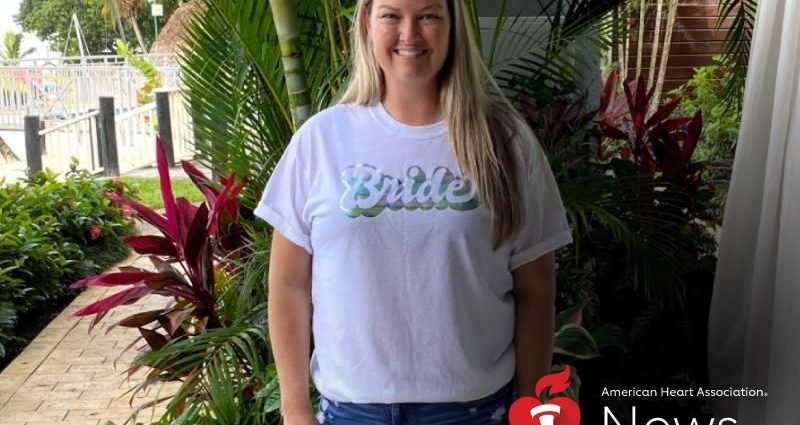MONDAY, Feb. 14, 2022 (American Heart Association News) — Tess Robinson sat in the lobby of the spa at her resort in Negril, Jamaica, waiting for a manicure and pedicure appointment. That evening at sunset, she and her boyfriend of seven years, Josh Oiler, were finally getting married.
COVID-19 had already derailed one wedding date. This time, the couple – who live in Norwich, Ohio, and had both been married before – decided to treat themselves to a private destination wedding.
As she waited, wearing a T-shirt with the word “bride” splashed across the front, Robinson started to feel queasy and shaky. She thought maybe she was dehydrated.
She drank some water but that didn’t help.
A stabbing pain started in the middle of her chest. It got worse. Then it turned unbearable.
Yet Robinson recognized this pain.
A month earlier, she felt it multiple times during one night. It only subsided when she crouched on the floor and put her head to her chest. When the problem never returned, she and Oiler dismissed it as indigestion.
Robinson had experienced other bizarre sensations in the past six months. They were so different and so random that they seemed unrelated.
It began when Robinson, a florist, would raise her left arm. She’d feel a sharp pain in the area around her collarbone and shoulder. Sometimes the pain kept her from raising her arm at all. She also occasionally felt nauseous.
Robinson went to an orthopedist, a chiropractor and a massage therapist for her arm. All had different theories. The orthopedist suggested she see a cardiologist, which seemed unnecessary for a 36-year-old in good health who had never smoked. There was, however, a bit of a family history. Her paternal grandmother had a major heart attack at age 53, followed by several smaller heart attacks and strokes over the next two decades. (She lived to be 77.) While Robinson included it in paperwork for her primary care physician, she never thought about it during this time.
Still, Robinson asked her physician for an electrocardiogram. A month before the wedding, the results were normal.
Back at the Jamaican spa, the manicurist came to get the bride-to-be.
By this point, the pain was so intense that Robinson started to cry.
“Don’t worry,” the woman said, handing her a lemongrass-scented washcloth. “You’re just nervous on your wedding day.”
Robinson said wasn’t the case, then got into the crouching position that had worked when she felt the stabbing pain in the middle of the night. It didn’t help.
A resort nurse was summoned. A doctor was summoned from two hours away in Montego Bay. Oiler was called.
“Your wife is having chest pains,” a spa attendant told him.
The doctor’s portable EKG showed Robinson was likely having a heart attack. He gave her morphine for the pain. It made little difference.
He ordered an ambulance – but only after Oiler’s credit card cleared the $900 charge.
Then came another delay. The ambulance was slowed by a holiday festival that filled the streets with partiers and traffic.
EMTs gave her nitroglycerin tablets to dilate her arteries and improve the blood flow to her heart. She was admitted to the hospital only after Oiler put another $6,000 on his credit card.
Emergency room workers cut open Robinson’s “bride” T-shirt to examine her. Yet they lacked the expertise or equipment needed to confirm a diagnosis. That would require an ambulance to Kingston or an airlift to Miami. And either of those would require more upfront money.
In need of advice, Oiler connected with a cardiologist in Zanesville, the city where both he and Robinson worked. He also started an online fundraising campaign that would eventually gather almost $44,000.
Because the flight to Miami would take about as long as the drive to Kingston, they opted for a flight. It cost around $18,000 and wasn’t covered by their travel insurance.
By the time Robinson reached the Miami hospital, three days had passed since the onset of pain at the spa. As she and Oiler outlined the various painful episodes from the last six months, a doctor said, “Google ‘symptoms for heart attacks in women.’ Yours are classic.”
A cardiac catheterization procedure confirmed a heart attack. She had a 99% blockage in one of her heart’s main arteries. Doctors were able to open it with a stent.
Heart disease is the No. 1 cause of death in the United States and kills more women each year than all forms of cancer combined.
Doctors struggled to explain the source of her problem. Their best guess traced it to a pregnancy complication marked by high blood pressure. (From previous marriages, Robinson has two daughters and Oiler has a son and a daughter.)
Two days after receiving the stent, Robinson left the hospital. The couple took their time driving to Ohio in a rental car.
Robinson started cardiac rehabilitation a week later and went three times a week for four months.
“Seeing my strength from the beginning to the end was an amazing change,” she said.
Still, Robinson felt depressed. She withdrew from others. She felt sorry for herself as she struggled with her new identity: heart attack survivor.
There’s also the identity she lacks: Married.
Although the couple started wearing their rings, they’ve yet to exchange vows.
They don’t have a date. But they do know where it won’t be.
“Jamaica was so beautiful,” Robinson said, “but we decided to never fly international again.”
American Heart Association News covers heart and brain health. Not all views expressed in this story reflect the official position of the American Heart Association. Copyright is owned or held by the American Heart Association, Inc., and all rights are reserved. If you have questions or comments about this story, please email editor@heart.org.
By Diane Daniel
Copyright © 2025 HealthDay. All rights reserved.

